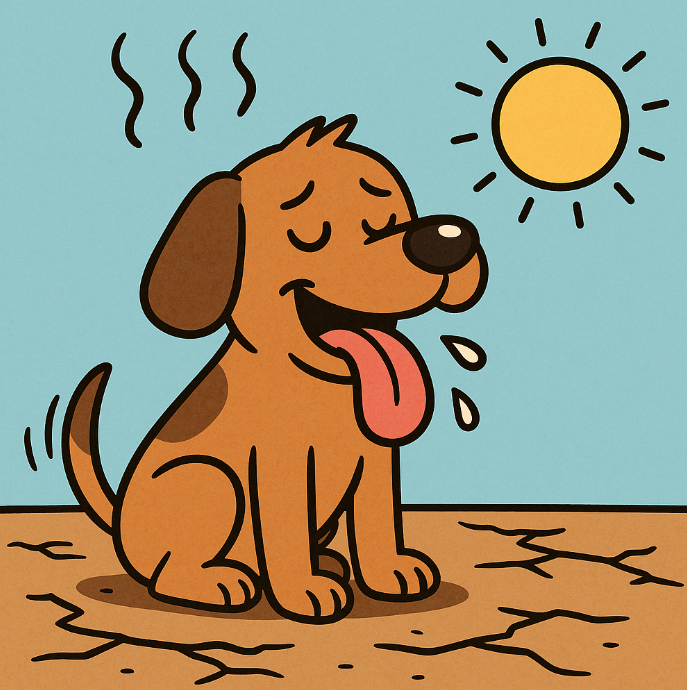
Pet Care During a Heat Wave
As summer temperatures soar, ensuring our pets stay cool and hydrated becomes a top priority. Extreme heat poses several risks, including dehydration and heat stress, particularly for older animals or those with pre-existing conditions. In this blog post, we explore evidence-based tips to help your beloved companion beat the heat while staying safe and comfortable.
1. Keep Them Well Hydrated
Fresh Water is Essential
- Multiple Stations: Place fresh, cool water in several locations around your home to encourage regular drinking.
- Observe Drinking Habits: A noticeable change in how much your pet drinks can be an early sign of discomfort.
Wet Food Can Help
- Extra Moisture: Incorporating wet food into your pet’s diet can increase fluid intake and help keep them hydrated during the hottest days.
2. Create a Cool Indoor Environment
Temperature Control
- Air Conditioning or Fans: Use air conditioning or fans to circulate cool air. For sensitive pets, try to avoid directing airflow directly onto them.
- Block the Sun: Close your curtains or blinds to reduce indoor temperatures caused by direct sunlight.
Cooling Mats and Pads
- Accessible Relief: Cooling mats or pads are an excellent option, especially for older pets or those with mobility issues.
Ventilate and Shade
- Keep it Airy: Ensuring proper ventilation and having shaded resting spots can make your pet’s indoor environment much more comfortable.
3. Adjust Exercise and Outdoor Time
Timing is Everything
- Cooler Hours: Schedule walks or play sessions during early mornings or late evenings when the temperatures are lower.
Provide Shade
- Outdoor Comfort: Always ensure there’s a shaded area available on outdoor adventures, whether it’s a tree, canopy, or portable shelter.
Monitor for Signs of Overheating
- Early Indicators: Watch for changes such as excessive panting, drooling, or lethargy. These may be early indicators your pet is overheating.
4. Recognize the Warning Signs of Heat Stress
Know What to Look For
- Early Warnings: Panting, increased drooling, or unresponsiveness can imply your pet is struggling with the heat.
- Seek Immediate Help: More severe symptoms—such as vomiting, uncoordinated movements, or collapse—require urgent veterinary care.
Utilize Technology
- Useful Apps: Consider pet health apps or local weather alerts that can remind you to check on your pet during extreme conditions.
5. Additional Considerations
Safety First
- Never Leave in a Vehicle: Cars can quickly transform into ovens even on mild days; always leave your pet in a climate-controlled environment.
Consult Your Veterinarian
- Tailored Advice: Pets with pre-existing health conditions—such as heart or respiratory issues—might require specialized care. Always consult your veterinarian for personalized guidelines.
Special Care for Sensitive Breeds
- Recognize Vulnerabilities: Breeds with thicker coats or brachycephalic (flat-faced) features are often more susceptible to heat stress. Extra precautions may be necessary to keep these pets comfortable.
Final Thoughts
Heat waves are a challenge not only for us but also for our furry family members. By ensuring they stay hydrated, cool, and well-monitored for signs of distress, you can help safeguard their health during extreme temperatures. While these tips are backed by current veterinary research, remember that your pet’s individual needs may vary. Always consult with your veterinarian for direct recommendations that best suit your pet’s requirements.
References
- O’Malley, K. G. (2020). “Management of Heat Stress in Pets: Guidelines for Dogs and Cats.” Journal of Small Animal Practice.
- American Veterinary Medical Association (AVMA). (2021). Heat Stroke in Pets.
Stay cool and take care of your pet this summer, ensuring each day is a safe and comfortable one for your furry friends!
Please consult a veterinary professional for individualized guidance regarding your pet’s health during extreme weather conditions.




